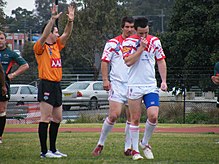High tackle
[4][5] According to World Rugby laws, "a player must not tackle an opponent early, late or dangerously.
"[6]Reducing player injuries sustained from high tackles has long been a goal of World Rugby.
[11] Initial trials of this rule change from the Fédération Française de Rugby (FFR) has had positive results, showing that reduction of permissible tackling to waist height reduces the number of head impacts and player injuries.
"[7] In 2019, the Australian Rugby League Commission (ARLC), the governing body of the National Rugby League (NRL) cracked down on 'crusher tackles', a particularly dangerous type of high tackle in which a defender forces a player’s head towards their torso in contact.
A player is guilty of misconduct if they use a shoulder charge, which is defined as when "a defender, without attempting to tackle, grab or hold the ball-carrier (or any opposing player) using the arms or hands, makes direct physical contact with the shoulder or the upper arm (tucked into the side).

